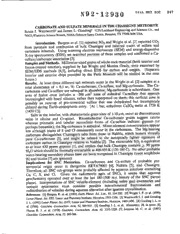
NASA Technical Reports Server (NTRS) 19920003712: Carbonate and sulfate minerals in the Chassigny meteorite PDF
Preview NASA Technical Reports Server (NTRS) 19920003712: Carbonate and sulfate minerals in the Chassigny meteorite
N92"12930 54th MET SOC 247 CARBONATE AND SULFATE MINERALS IN THE CHASSIGNY METEORITE Susan J. Wentworth 1and James L. Gooding z 1C23/Locldaeed Engineering and Sciences Co., and 2SN21/Planetary Science Branch, NASA/Johnson Space Center, Houston, "IX 77058-3696 USA. Introduction. Burgess et al. [1] reported SO2 and Wright et al. [2] reported CO 2 from pyrolysis and combustion of bulk Chassigny and inferred traces of sulfate and carbonate minerals. Using scanning eIectron microscopy (SEM) and energy-dispersive X-ray spectrometry (EDS), we searched portions of these samples and confirmed a Ca- sulfate/carbonate association [3]. Samples and Methods. Millimeter-sized grains of whole-rock material (both interior and fusion-crusted exterior), supplied by Ian Wright and Monica Grady, were examined by SEM/EDS methods [4,5], including direct EDS for carbon and oxygen. (Separate interior and exterior chips provided by the Paris Museum will be studied in the near future.) Results. At least three different salt minerals occur in the Wright et al. [2] samples at a total abundance of < 0.1 wt. %: Ca-carbonate, Ca-sulfate, and Mg-carbonate. The Ca- carbonate and Ca-sulfate are subequal in abundance; Mg-carbonate is subordinate. One area of fusion crust includes a -200 t_m2 zone of anhedral Ca-sulfate that appears intermingled with fused silicates, rather than superposed on them; this surficial zone is possibly an outcrop of pre-terrestrial sulfate that was dehydrated but incompletely ablated during Earth-atmospheric entry. [At 1 bar, anhydrous CaSO4 melts at 1720 K (1450 C)]. Salts in the interior, with characteristic grain sizes of 1-10 _m, occur as discontinuous veins in olivine and Cr-spinel. Rhombohedral Ca-carbonate grains suggest calcite whereas prismatic and tabular monoclinic forms of Ca-sulfate indicate gypsum (or perhaps bassanite); the Mg-carbonate is anhedral. Minor-element concentrations appear low although traces of S and C1 consistently occur in the carbonates. The Mg-bearing carbonate distinguishes Chassigny's salts from those in Nakhla, which feature virtually pure Ca-carbonate [5], and might be related to the isotopically lighter signature of carbonate carbon in Chassigny relative to Nakhla [2]. The extractable SO2 is equivalent to at least 430 ppmw gypsum [1], and implies that bulk Chassigny contains 2 90 ppmw H20 which should be thermally extractable at 400-450 K (130-180 C). No other probable water-bearing secondary phases have yet been recognized in Chassigny (trace amphibole [6] and biotite [7] are igneous). Implications for SNC Meteorites. Ca-carbonate and Ca-sulfate of probable pre- terrestrial origin occur in shergottite EETA79001 [4], Nakhla [5], and Chassigny. Therefore, all SNC sub-groups were probably affected by aqueous solutions containing Ca, C, S, and Cl. Given the radiometric ages of SNCs, it seems that aqueous geochemistry operated over at least the last 180-1300 m.y. history of the SNC parent planet. Interpretations of SNC volatile-element (including noble gas) inventories and isotopic systematics must consider possible interelemental fractionations and redistribution of volatiles during aqueous alteration after igneous crystallization. References: [1] Burgess R. et al. (1989) Earth Planet. Sci. Lett., 93, 314-320. [2] Wright I. P. et al. (1990) Lunar Planet. Sci. XXI, Lunar and Planetary Institute, Houston, 1353-1354. [3]Wentworth S. J. and Gooding J.L. (1991) Lunar Planet. Sci. XXII, Lunar and Planetary Institute, Houston, 1489-1490. [4]Gooding J. L. et al. (1988) Geochim. Cosmochim. Acta, 52, 909-915. [5] Gooding J. L. et al. Meteoritics, 26, in press. [6] Horan R. J. et al. (1978) Geochim. Cosmochim. Acta, 42, 1213-1229. [7] Johnson M. C. et al. (1991) Geochim. Cosmochim. Acta, 55, 349-366.
